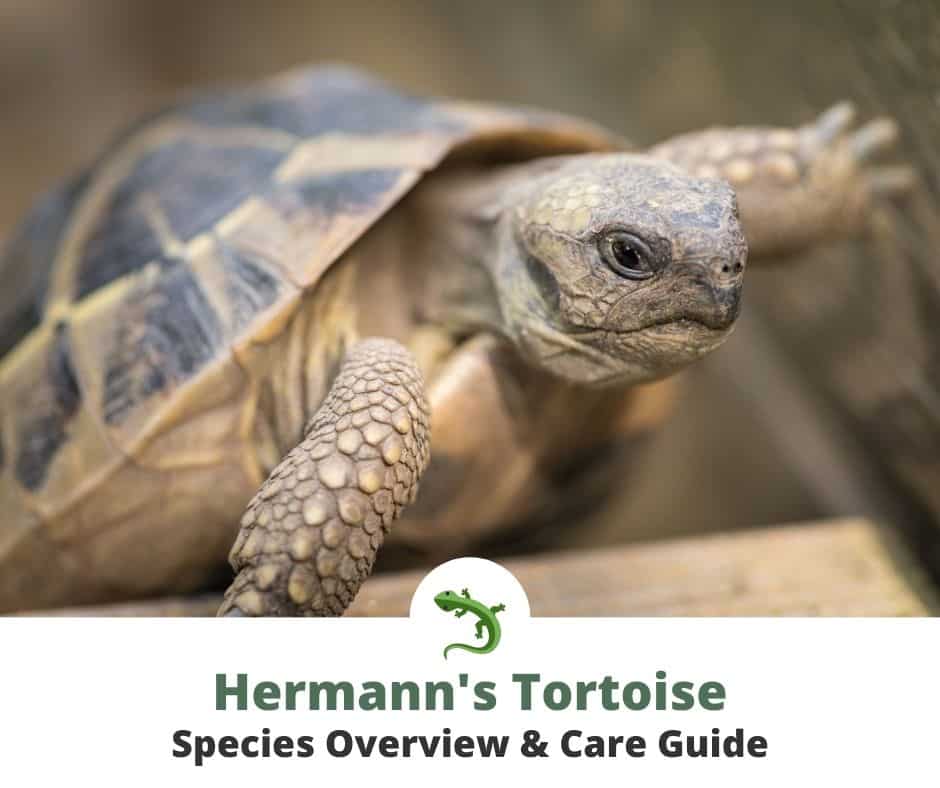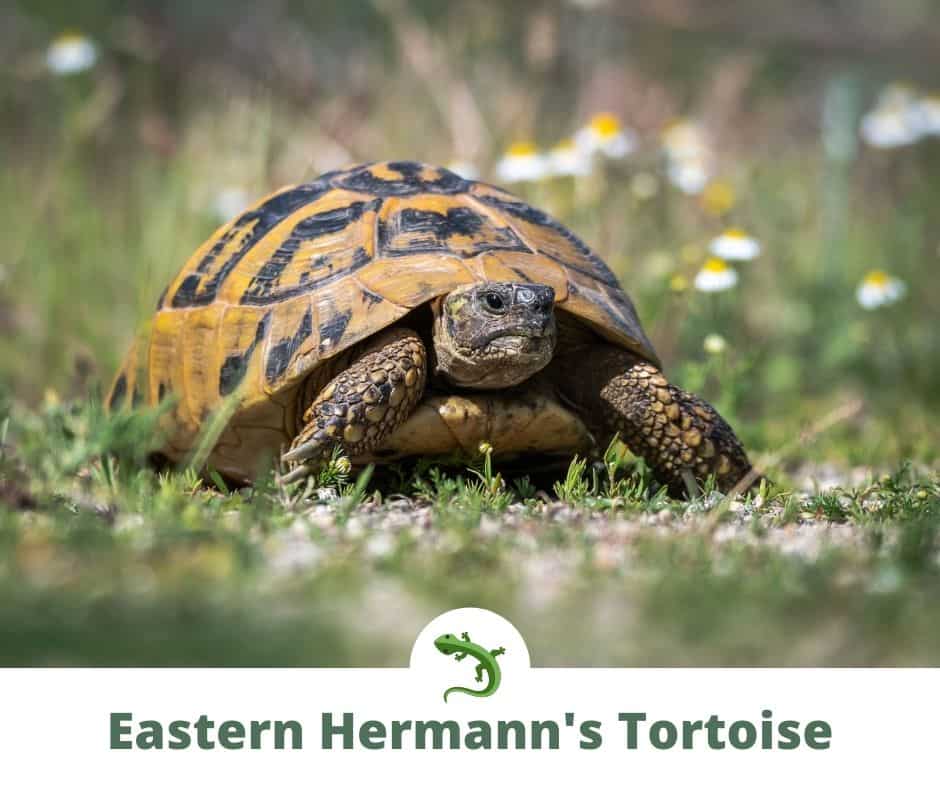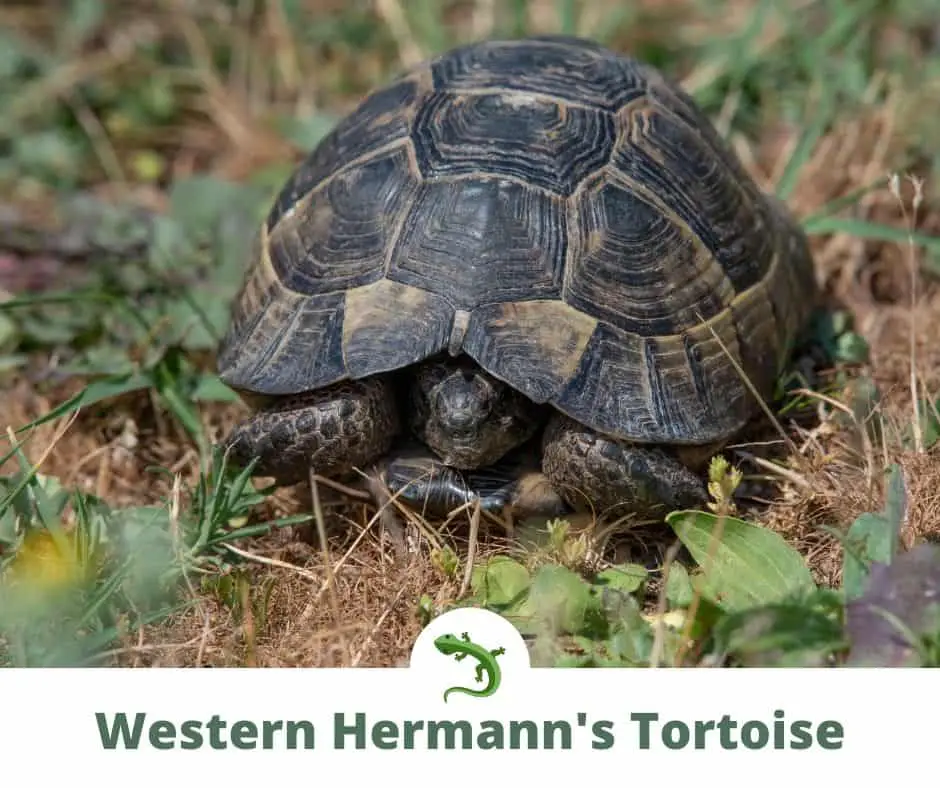The Hermann’s Tortoise is one of the most popular species of tortoise. They can be kept in captivity, but like many turtles, they do not enjoy being handled.
In this guide, you’ll learn:
- What is a Hermann’s tortoise?
- How to care for a Hermann’s tortoise
- How big do they get?
- How long do they live?
- How much they cost?

Species Summary
The Hermann’s tortoise (Testudo hermanni) is a small, land-dwelling turtle native to the Mediterranean region. It is one of five species in the genus Testudo and is also known as the European spur-thighed tortoise.
These tortoises inhabit dry grasslands and scrubland areas near water sources such as streams or rivers in their natural habitat. These areas provide plenty of rocks for them to hide under if needed. They will also venture into nearby woodlands in search of food sources like berries and insects, which comprise most of their diet. They may also consume plant matter such as flowers and leaves when available.
Male Hermann’s tortoises can be distinguished by their longer tails compared to females.


How Big Do Hermann’s Tortoises Get?
Hermann’s tortoises are small to medium-sized reptiles, typically reaching lengths up to 8 inches.
They have an oval shell with a high domed carapace ranging from yellowish brown to dark brown. The underside of its shell, or plastron, is usually lighter than its carapace and may have some yellow spots or blotches. The carapace is covered in scutes or scales that give it an attractive patterned look.
How Long Do Hermann’s Tortoises Live?
Hermann’s tortoises can live for up to 50 years in captivity. In the wild, they may only live 10–20 years due to predation by birds and other animals and habitat destruction caused by human activity such as farming or development projects.
Caution
Hermann’s tortoises can and will burrow out of their enclosure if possible, so be careful if keeping them outdoors!
How To Care For A Hermann’s Tortoise
Enclosure Requirements
Hermann’s tortoises require a spacious enclosure that is at least twice as long as the length of your pet. A glass aquarium with a secure lid, or an outdoor pen with walls at least 12 inches high, are both suitable housing options. Additionally, it is important to provide plenty of substrate for burrowing and hiding spots, such as rocks and logs.
Pro-tip
For a hatchling tortoise that is less than 4 inches, a 50-gallon Rubbermaid container is an excellent enclosure.
Tank Setup 🏠
Hermann’s tortoises need temperatures between 75-85°F during the day and 65-75°F at night. It is also important to maintain humidity levels between 50%-70%. To do this, you can mist the enclosure daily or use a reptile fogger to create more humid air.
Caution
We do NOT recommend heat rocks and heat pads. Stick to basking lights to provide heat indoors.
Substrate 🍂
Pro-tip
Provide at least 4 inches of a substrate to allow your tortoise to burrow. If you look into the enclosure and cannot find your tortoise, this means they are comfortable!
Food & Water Requirements 🥕
The diet of Hermann’s tortoise should consist mainly of leafy greens like dandelion leaves, collard greens, kale, turnip tops, etc., along with some fruits like apples or melons (in moderation). Additionally, they should be fed high-quality commercial foods explicitly designed for reptiles. It is also essential to provide calcium supplements regularly to prevent metabolic bone disease due to a lack of calcium intake from their diet alone.
Pro-Tip ⚡
Low protein and high fiber, calcium-rich foods are essential to keeping Hermann’s tortoises.
Common Health Problems ⚕️
Several common health problems are associated with Hermann’s tortoises, including respiratory infections, eye infections, shell rot, and metabolic bone disease (MBD).
- Respiratory infections
- Eye infections
- Shell rot
- Metabolic bone disease
Respiratory infections can occur due to poor ventilation or unclean living conditions; symptoms include wheezing and difficulty breathing.
Eye infections can also develop if there is not enough humidity in the environment; symptoms include redness around the eyes or discharge from them.
Shell rot is caused by bacteria entering through cracks in the shell; it appears as white patches on the carapace and plastron, which can cause pain when touched.
Finally, Metabolic Bone Disease (MBD) occurs when calcium levels are too low in a diet; it causes softening of bones leading to deformities such as bent legs or curved spines.
FAQs
Are Hermann tortoises easy to take care of?
Hermann tortoises are relatively easy to take care of. They require a spacious enclosure with adequate temperature and humidity levels and a diet consisting mainly of leafy greens and vegetables. A shallow water dish should also be provided for drinking and soaking. With proper husbandry, these reptiles can make excellent pets that live long lives!
Can you keep Hermann’s tortoise inside?
Yes, Hermann tortoises can be kept inside. They need a large enclosure with plenty of space to move around in and an area that provides UVB lighting and basking spots. The temperature should also be regulated within their preferred range of 75-85°F (24-29°C).
How big of an enclosure does a Hermanns tortoise need?
Hermanns tortoises require a large enclosure to accommodate their active lifestyle. A minimum of 6 square feet per adult tortoise is recommended, but larger enclosures are preferred for more natural movement and exploration. The enclosure should be at least twice as long as the tortoise’s length, with walls at least 12 inches high to prevent escape.



2 thoughts on “Hermann’s Tortoise Care Guide”
Thank you! If a tortoise is kept in a large rubbermaid container, should there be a lid? How should a heat lamp stay in place over the container?
If you search on google, they make heat lamp stands out of wrought iron that work super well!
Otherwise, try being crafty and building one or fashioning something out of wood.
If a lid is needed to keep proper humidity, use one, however for an adult tortoise the enclosure shouldn’t need a lid over it.